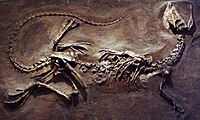
Photo from wikipedia
Abelisaurids were one of the most successful theropod dinosaurs during Cretaceous times. They are featured by numerous derived skull traits, such as heavily ornamented bones, short and tall snout, and… Click to show full abstract
Abelisaurids were one of the most successful theropod dinosaurs during Cretaceous times. They are featured by numerous derived skull traits, such as heavily ornamented bones, short and tall snout, and a strongly thickened cranial roof. Furthermore, nasals are distinctive on having two distinct nasal patterns: strongly transversely convex and heavily sculptured (e.g., Carnotaurus), and transversely concave, with marked bilateral crests and poorly sculptured surfaces (e.g., Rugops). Independently of the pattern, some abelisaurid nasals (e.g., Rugops) show a distinctive row of large foramina on the dorsal surface, which were in general associated to skin structures (scales). Skorpiovenator bustingorryi is a derived abelisaurid coming from the upper Cretaceous beds of northwestern Patagonia, represented by an almost complete skeleton including a well-preserved skull. Particularly, the skull of Skorpiovenator shows nasal bones characterized by being transversely concave, rimmed by lateral crests and with a conspicuous row of foramina on the dorsal surface. But more interesting is that the skull roof also exhibits a row of large foramina that seem to be continuous with the previous nasal foramina. CT scans made on the skull corroborates a novel feature within theropods: the nasal foramina on the external surface are linked to an internal canal that runs across the nasal bones. We compared this feature with CT scans of Carnotaurus and revealed that it also possess an internal system as in Skorpiovenator, but being notably smaller. The symmetry and disposition of the foramina in the nasal and skull roof bones of Skorpiovenator would indicate a neurovascular correlate (i.e., blood vessels and nerves), probably to the lateral nasal and supraorbital vessels and the trigeminal nerve. The biological significance of such neurovascular system can be conjectured from several hypotheses. A possible one involves an enhanced blood volume in these bones linked to a zone of thermal exchange, which may help avoid overheat of encephalic tissues. Another plausible hypothesis takes into account the presence of display skin structures in which blood volume nourished the mineralized skin, which would have a role in intraspecific communication. However, other more speculative explanations should not be discarded such as a correlation with integumentary sensory organs.
Journal Title: Journal of anatomy
Year Published: 2020
Link to full text (if available)
Share on Social Media: Sign Up to like & get
recommendations!